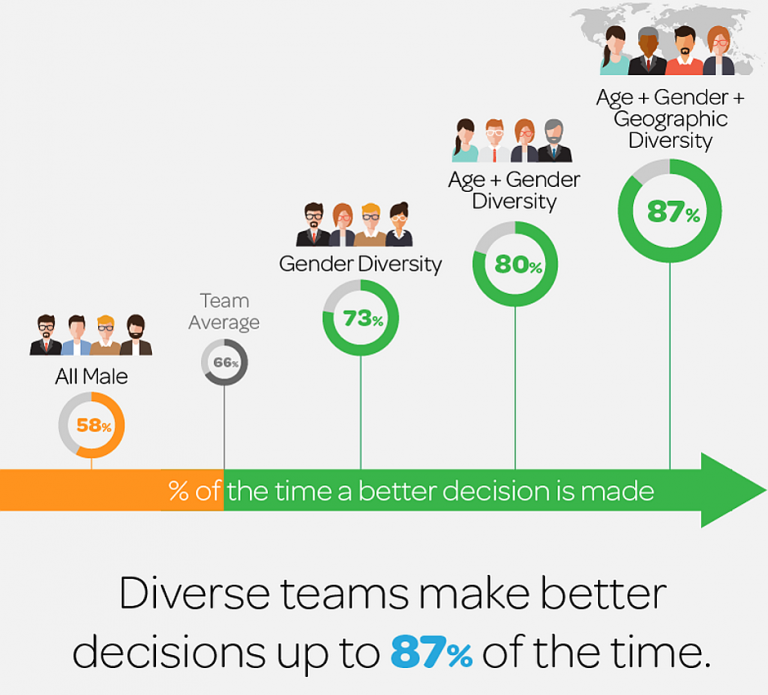
Inclusion and diversity found to lead to better decision-making
This article is part of an ongoing series of articles on cultural awareness in KM.
We’ve previously looked at academic research showing how diversity can benefit organisational performance, and heard a startup founder’s thoughts on how diversity can stimulate and facilitate innovation.
New organisational research provides further support for the benefits of workforce diversity, finding that inclusive decision-making activates diversity for better business performance and a competitive advantage.
The study was based on 566 real business decisions made by 184 business teams in a wide variety of companies from July 2015 through June 2017. The decisions were drawn from aggregate anonymized data in the Cloverpop decision-making platform.
Findings
The Cloverpop research found that:
- On average, teams make better business decisions than individuals about 66 percent of the time. Teams bring more perspectives, experience, and information, which helps to reduce cognitive biases and improves accountability.
- As the diversity of teams increases, so does the chance of making better decisions. The most diverse teams made better decisions 87 percent of the time.
- While inclusive decision-making delivers better decisions, diverse teams are more likely to encounter operational friction when executing decisions after they are made. In simple terms, homogeneous teams make worse decisions, and diverse teams struggle to put their decisions into action.
- All-male teams are common. Only 62 percent of business decision-making includes direct participation by a mix of both men and women in an average company.
- The worse-of-both-worlds combination of all-male teams making decisions that were then executed by diverse organizations (i.e. with higher operational friction) is very ineffective. Only 28 percent of such decisions were both better upfront and also delivered results that met or exceeded expectations, performing 15 percent worse than average.
- By comparison, decisions that were both made and executed by gender diverse teams performed 6 percent better than average. Adding age diversity increased performance to 45 percent better than average, and adding geographic diversity boosted performance an incredible 60 percent above average.

Practical approaches for inclusive decision-making
In response to the findings, Cloverpop recommends the following approaches:
Purposefully include diverse people in the decision-making process
The benefits of inclusive decision-making happen as soon as you include just one woman and one man, one older and one younger person, or someone from another geography. This can be hard to do for a diverse and geographically distributed group of people. To make it work, each person has to be comfortable actively weighing in on decisions, and able to do it easily. Time zones, power dynamics, cultural challenges and personality differences can all get in the way.
Implement seven simple steps to stop mistakes and speed up decisions
Cloverpop contends that this seven step checklist can improve the quality of every business decision:
- Include a diverse team of three or more people.
- List the business goals impacted by the decision.
- List at least four realistic choices.
- Identify any critical missing information.
- Explain the expected future impact of the decision.
- Record and communicate the decision in writing.
- Follow up to assess how well results meet expectations.
Shine a light on decision metrics to accelerate change
Share your decisions, and the data from measuring the implementation and impact of those decisions, and also data such as that discussed in this article. When people see the data, they’re not only more aware, they also get curious about what’s happening and motivated to make it better.
Research limitations
It should be noted that the research referenced in this article is organisational research rather than peer-reviewed academic research, and is also based on assumptions in regard to the Cloverpop decision-making platform:
This decision study was based on 566 real business decisions made by 184 business teams in a wide variety of companies from July 2015 through June 2017. The decisions were pulled from aggregate anonymized data in the Cloverpop decision-making platform, allowing analysis of an average of 350 data points for each decision. These were typical management and executive decisions about hiring and staffing, project planning and prioritization, policy changes, resource allocations, customer proposals and similar management responsibilities.
The study was able to measure when teams made better decisions by tracking how often the decision maker changed their mind based on the input of the team. This is presumed to be a better decision since the Cloverpop process ensures that decisions are well framed with clear goals, adequate information and multiple alternatives to avoid groupthink.
Article sources: Forbes Leadership, Cloverpop.
Also published on Medium.






